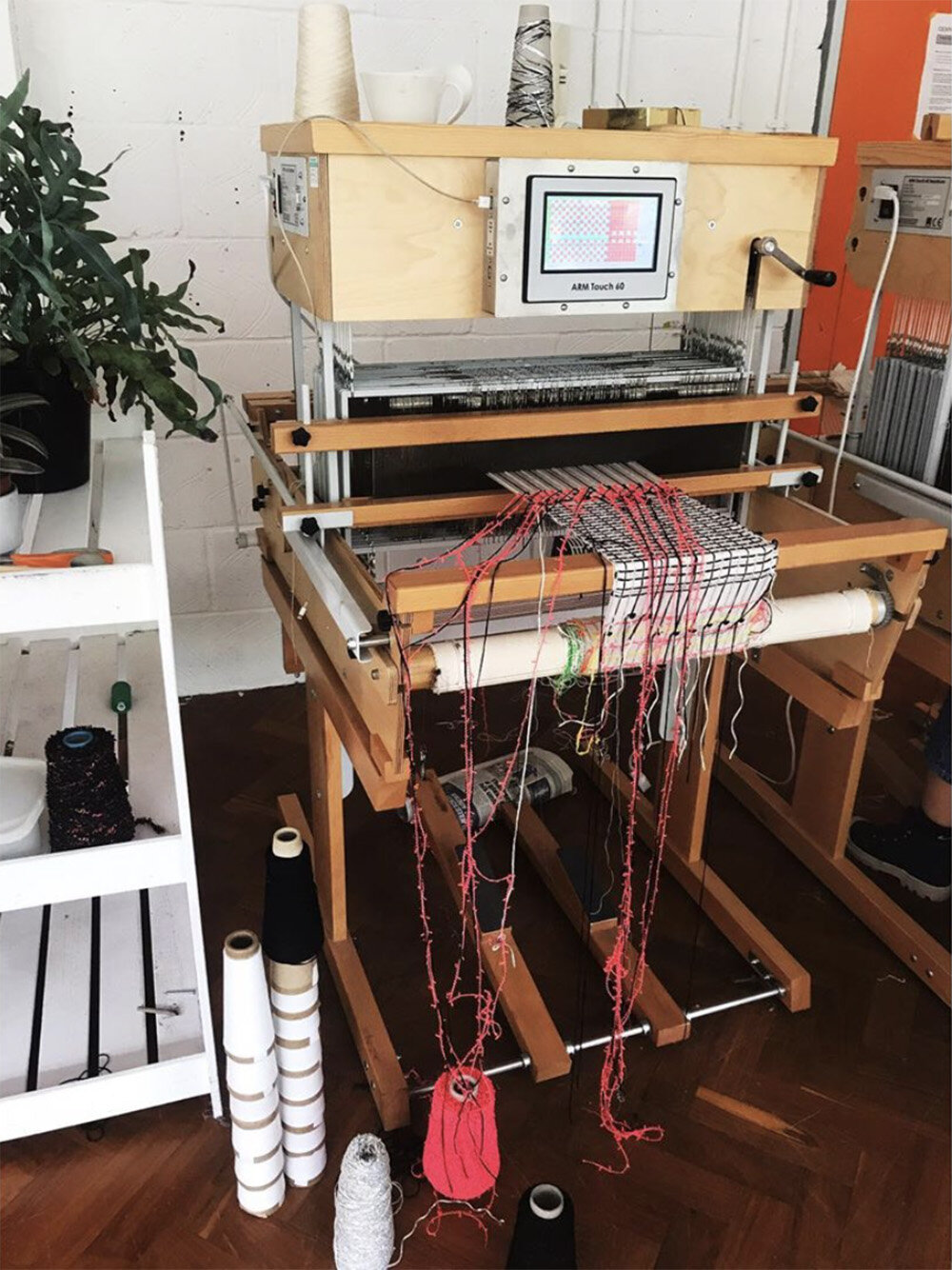Tengri textiles R&D: Alice Timmis Q&A
Alice Timmis leads Tengri’s Textiles Research & Development Project, run in partnership with the Business of Fashion, Textiles and Technology (BFTT). She explains how this project explores the commercial potential of yarn by-product fibres, with the aim of developing sustainable and technologically engaged fashion, textiles and technology products, services and experiences.
What’s your background? How did you get into weaving and textile R&D?
I graduated from the Royal College of Art with an MA in Woven Textiles in 2016. During my MA, our lecturers took us on visits to industrial mills. I was fascinated by the relationship between handwoven design and mill production – I knew I wanted to work between the two.
Upon graduating, I was invited to work in-house as a designer at Italy’s largest woven textile mill. Meanwhile, I began to take on handwoven commissions from London’s most experimental brands. My experience of working in industrial manufacture coincided with developing my expertise in creating handcrafted fabrics in collaboration with fashion brands.
I returned to London from Italy knowing that I wanted to build my own woven practice. The Clothworkers Foundation Award gave me financial support, and an advisory mentor, whilst I established my business. My studio is based at Cockpit Arts in South London. In my studio I have two hand looms – a small sampling loom and an AVL full-width production loom.
I continue to produce my fabrics industrially in mills, and I still work in Italy on a consultancy basis. Recent research projects have involved developing ways that mill textile waste can be re-fabricated into cloth. I have also worked on weaving with alternative fibres in response to a drop in demand for less ethical materials.
What attracted you to the BFTT Tengri project?
Tengri prides itself as a collective. The brand is built upon enduring relationships with high-quality suppliers and heritage manufacturers. Similarly, interpersonal relationships have been key to my own success working and establishing myself in the textile industry. Over the years I have built expertise working with the whole textile supply chain, including yarn manufacturers, fabric mills and textile finishers. The BFTT Tengri project requires this expertise.
I am used to leading individual clients through the collaboration process and acting as the mid-point between fashion houses and manufacturers. However, working as part of the Tengri team on a longer-term project gives me the opportunity to understand the brand at a much deeper level. This is essential for this project which aims to make changes in the fashion industry, and for working with Tengri which is a brand driven by philosophy.
During my career I have worked with mills and yarn manufacturers on research projects that aim to achieve circular manufacturing processes. This led me to become increasingly interested in the importance of sustainable fashion and processes.
The BFTT project is a great opportunity for me to be working alongside a larger research team. This includes Dr. Veronika Kapsali, who acts as my research mentor throughout the project. Veronika is the inventor of INOTEK, an award-winning biomimetic textile, and consults extensively on material science, functional apparel and fashion-tech.
What does the project aim to achieve?
The principal aim of the BFTT Tengri project is to explore the commercial potential of Tengri’s Yak yarn by-product (B & C grade).
At the moment, we are exploring innovative manufacturing approaches. We are also identifying appropriate routes to markets. This includes speaking to brands with whom we would like to collaborate, as well as identifying potential applications for the materials we produce. Throughout the project I am documenting all the knowledge and methods we are building. This is important so that the processes we develop can be applied to other similar fibres.
In what ways does this project explore the potential of new fibres and new blends of fibres?
Currently we are exploring the best ways to develop non-woven fabrics, and yarns that can be woven into fabrics. We have been establishing new partnerships with the UK's best manufacturers who have expertise in how we can blend the fibres to create yarns and fabrics suitable for various industries.
For example, we would like to create a worsted fabric with the fibre. Blending yak fibres with longer wool fibres will allow us to create worsted yarns. This wouldn’t be possible with 100% yak due to the short length of the fibres. Worsted yarns are more hardwearing and less prone to pilling. As well as working with mills, we are also conducting research at Leeds University to discover which is the best percentage of blend we can achieve for fabrics suitable for fashion, interiors and luxury automotive applications.
In addition to Tengri yak fibres, what specific materials have you been working with? Are there any indications of potential applications for these?
We have been researching various fibres to introduce into the Tengri collection of noble yak and camel fibres. And we’ve been exploring working with cellulose fibres (fibres from plants), and protein animal fibres. At Tengri, it is important that we keep our integrity in conserving and working with ethical suppliers.
For example, we have been scoping wool blends that will reflect Tengri’s deep-rooted respect for nature and can preserve cultural heritage. We will source either Blue Faced Leicester sheep’s wool, which is sourced locally to our manufacturers, or Khangai Wool from the region in Mongolia where Tengri works as a social enterprise with herders to source yak fibres.
As well as worsted fabrics, we plan to create fancy yarns with a wool blend suitable for fashion outerwear – specifically a textured yarn that can mimic and act as an alternative to fur!
This project has led to the creation of the Tengri Innovation Lab. How did the need for this lab become apparent, and what could it offer textile educators, designers and makers?
Manufacturers have very large minimum order quantities. This means it is impossible to make small trial runs before going into full production. Working on the BFTT Tengri project highlights the requirement for an innovation lab. We are one of many SMEs that would benefit from having easy access to small-scale spinning equipment so we can test ideas without committing to large quantities. The UK’s only existing spinning lab is at Leeds University and this is prioritised for their own research.
So Tengri plans to launch its very own innovation spinning laboratory. It will be open to other SMEs and designers to use as a bureau service. Furthermore, Tengri will also open up the facilities for educational establishments to use. Surprisingly, fashion and textile students barely learn about the process of spinning yarns. There is a gap in fashion and textile designers’ knowledge about this fundamental stage in the textile process. Tengri plans to work with universities to teach the next generation of fashion and textile designers about yarn manufacturing processes.
More broadly, how can innovation help the textile industry minimise its environmental impact and move towards sustainable growth?
The BFTT is an initiative focused on delivering innovation within the entire fashion and textile supply chain. SMEs like Tengri tend to have the most environmentally conscious approaches to creating fashion and textiles, compared to bigger companies. Hence, conducting R&D projects through companies like Tengri will allow the BFTT’s research team to have a greater impact on the textile industry as a whole.
The B & C grade fibres are an example of working on pre-consumer waste; textile leftovers that are discarded during the production process before the fabric or garment reaches the customer. Projects such as these are an example of how the industry can aim for zero waste during textile production. Hopefully the legacy of the BFTT Tengri project will also be an influence on other luxury makers, as well as mass-producers, to adopt minimal waste production methods.
What sort of new technologies might help with the creation of non-wovens out of yarn by-product?
Non-woven methods are less common in the production of fashion fabrics than weaving and knitting. It is really exciting to explore non-woven technologies to create fabrics with the yarn by-product – not least because non-woven processes also have sustainable benefits.
Needle-punching and hydro-entanglement are efficient technologies evolved from techniques originally developed in the nineteenth century. Either a bed of needles, or jets of water, push and pull through webs and fibres to entangle and interlock the fibres. Fabrics are formed and the process of making yarns is eliminated – hence the process requires less energy.
To ensure that the fabrics produced are of the highest quality, we will test the non-woven fabrics with technologies that rub textiles with a certain pressure over a period of time to ensure the fabrics will not pill. We will also use machines that test the fabric quality against tearing, and good crease recovery. Tengri has certain requirements that all its fabrics have to pass, to ensure their quality for the Tengri customer.
How might designers and customers benefit from discovering more about the importance of fabric structure?
Good quality fabrics dictate the quality of a garment. The handle, drape, and weight of the cloth is also fundamental in fashion design.
In education, woven textile students learn about the structure of cloth, and the infinite number of ways in which the vertical and horizontal yarns can intersect. Weavers understand the ways that different yarns can be combined for different qualities of cloth. Having collaborated with many fashion brands, I find it surprising how some fashion designers have such big gaps in their knowledge about fabric types. My clients often say that they enjoy collaborating with me as a weaver because they get to learn about the construction of cloth.
By understanding fabric, designers can ensure that the material they work with is good quality and can withstand the abrasion to which garments might be prone. Clothes can last a lifetime if the materials from which they are made are suitable. Fashion designers would benefit from understanding the structure of cloth for this reason.
This is what has impressed me since working with Tengri – the knowledge and emphasis that the brand places on the quality of the fabrics used to make up garments in its collection.




